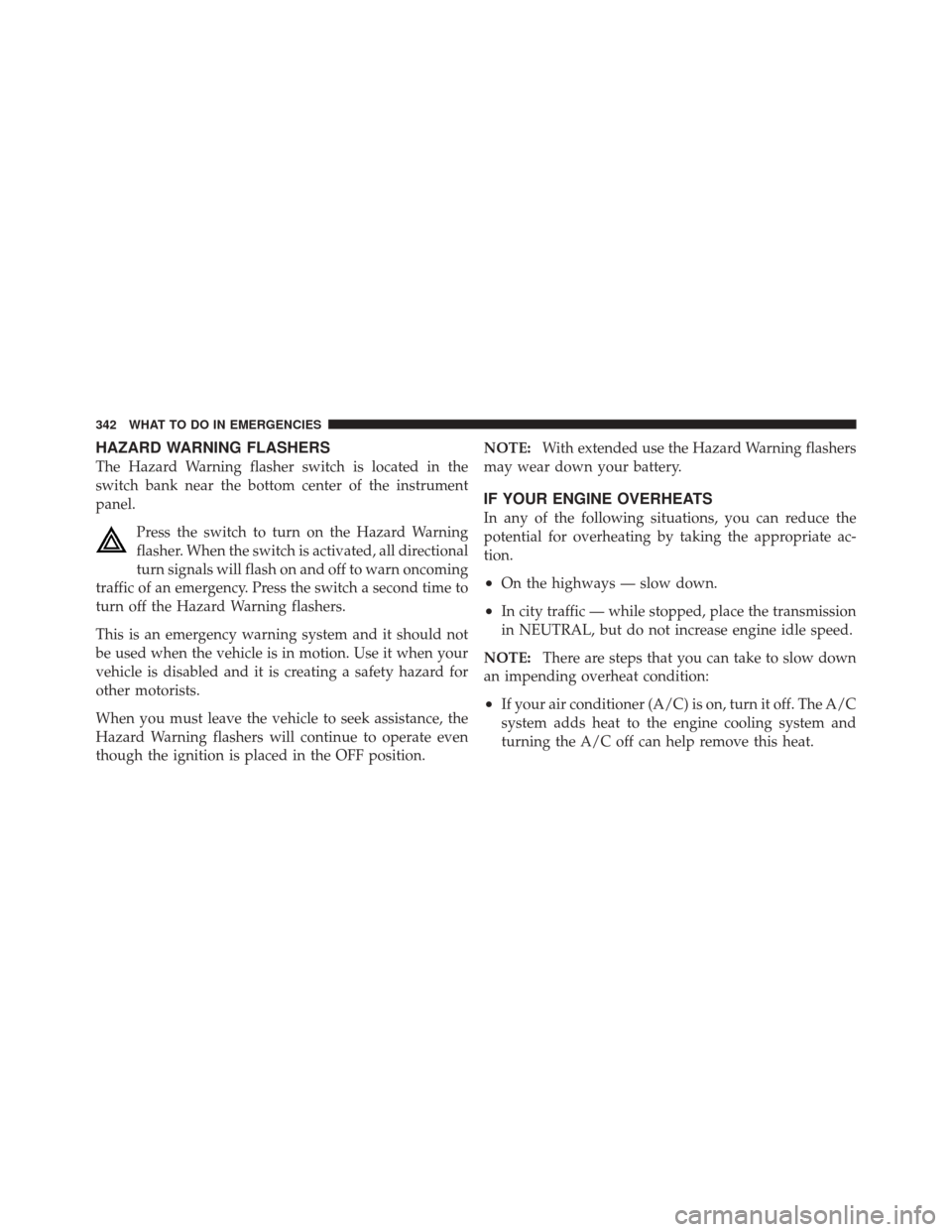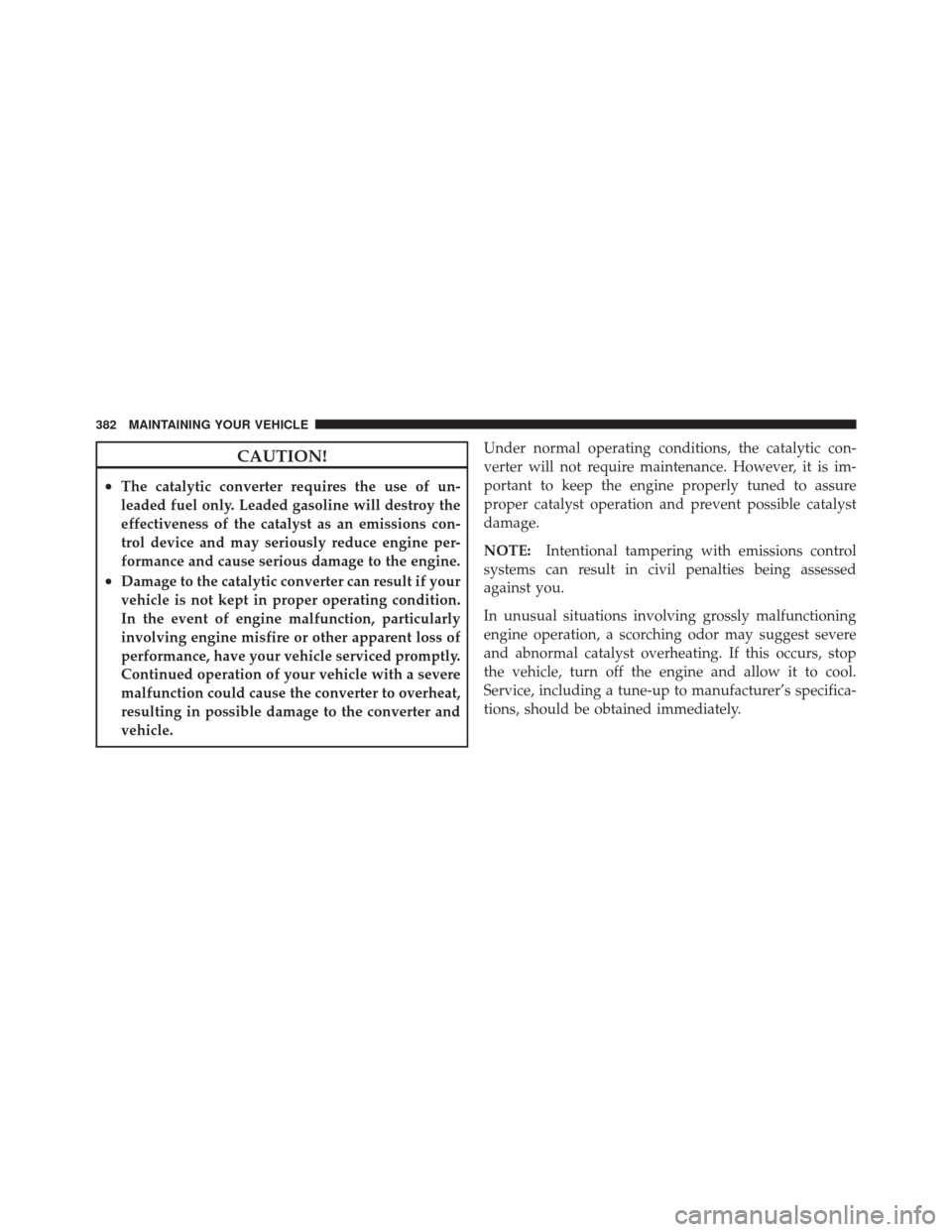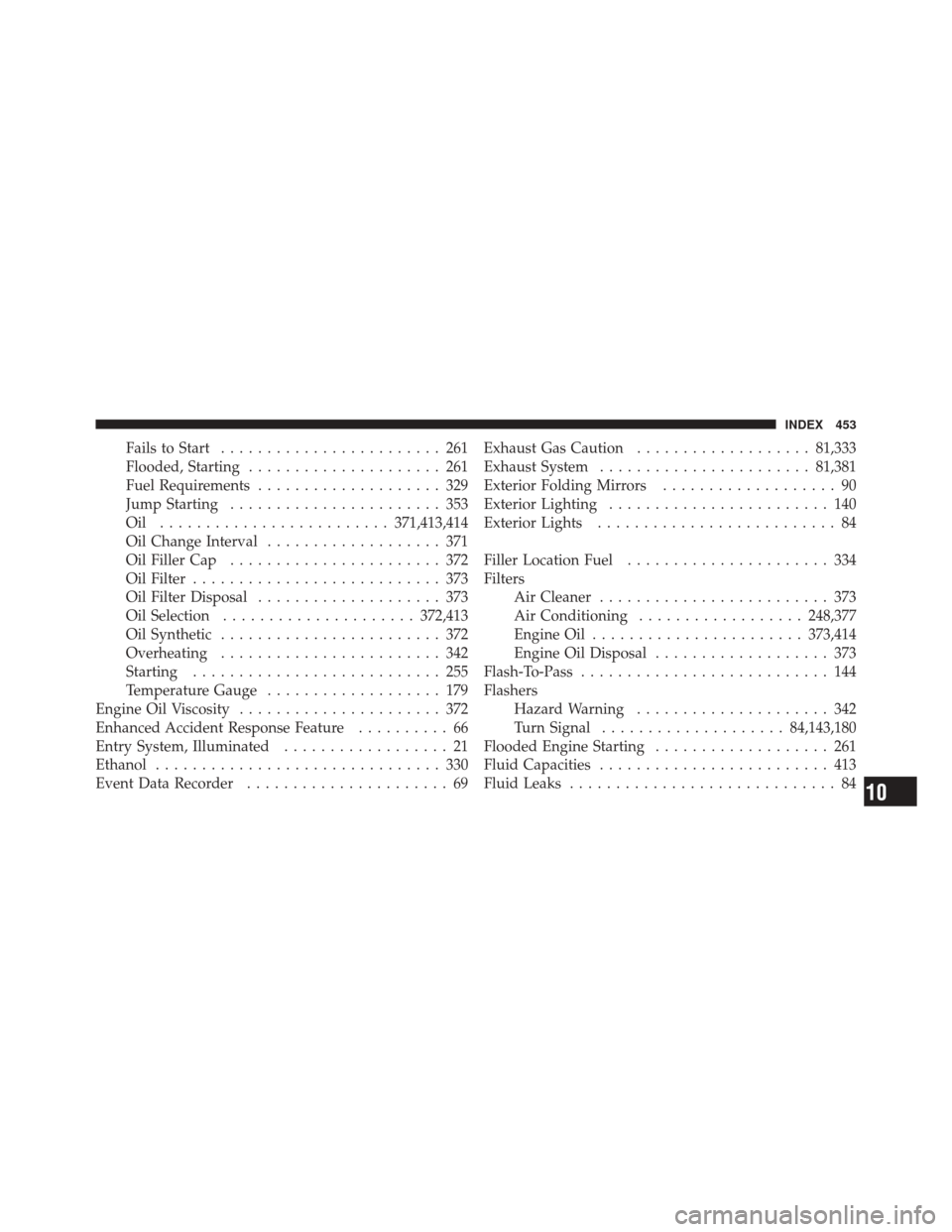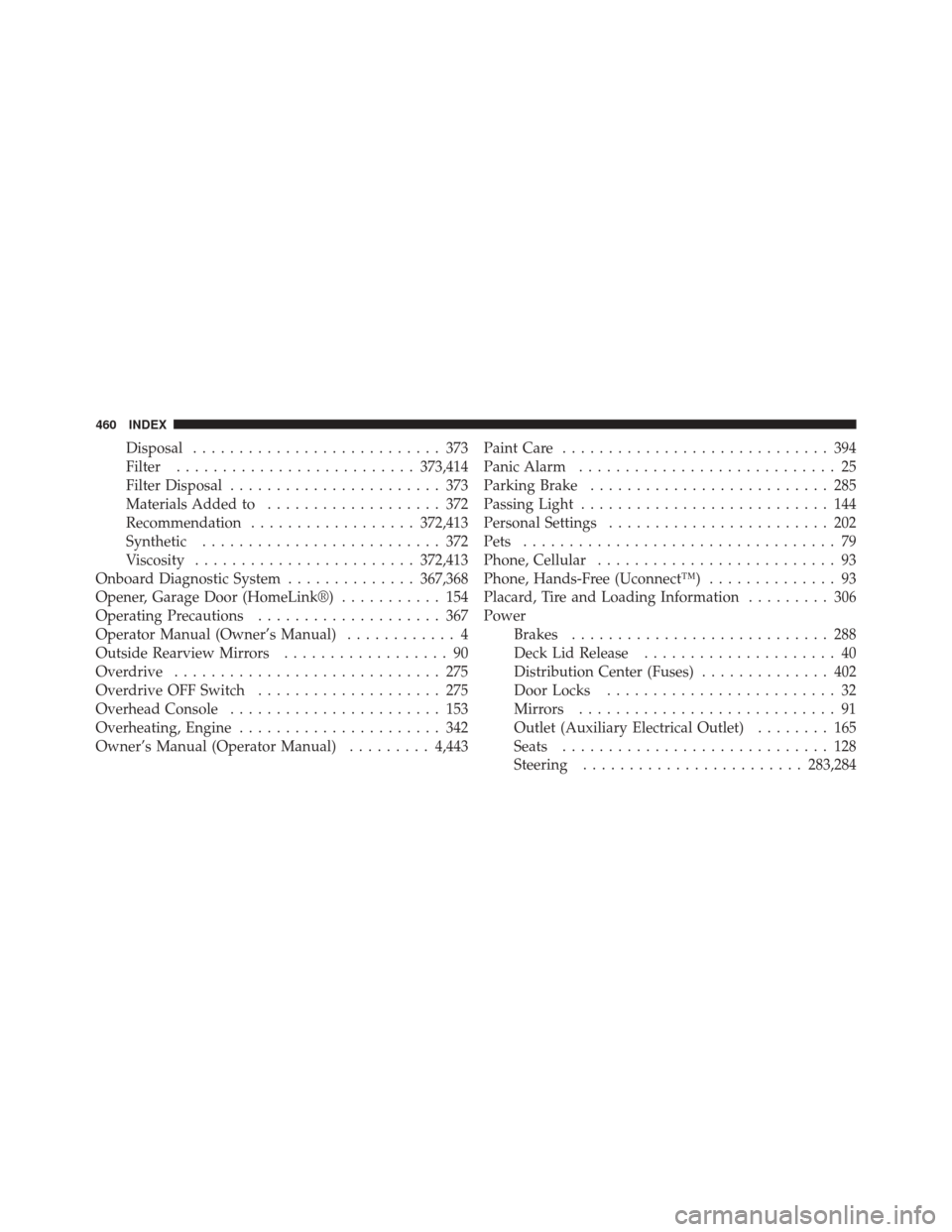2012 DODGE CHALLENGER SRT heating
[x] Cancel search: heatingPage 312 of 471

WARNING!
Overloading of your tires is dangerous. Overloading
can cause tire failure, affect vehicle handling, and
increase your stopping distance. Use tires of the
recommended load capacity for your vehicle. Never
overload them.
TIRES — GENERAL INFORMATION
Tire Pressure
Proper tire inflation pressure is essential to the safe and
satisfactory operation of your vehicle. Three primary
areas are affected by improper tire pressure:
Safety
WARNING!
•Improperly inflated tires are dangerous and can
cause collisions.
•Under-inflation increases tire flexing and can re-
sult in over-heating and tire failure.
•Over-inflation reduces a tire’s ability to cushion
shock. Objects on the road and chuckholes can
cause damage that result in tire failure.
•Over-inflated or under-inflated tires can affect
vehicle handling and can fail suddenly, resulting
in loss of vehicle control.
•Unequal tire pressures can cause steering prob-
lems. You could lose control of your vehicle.(Continued)
310 STARTING AND OPERATING
Page 344 of 471

HAZARD WARNING FLASHERS
The Hazard Warning flasher switch is located in the
switch bank near the bottom center of the instrument
panel.Press the switch to turn on the Hazard Warning
flasher. When the switch is activated, all directional
turn signals will flash on and off to warn oncoming
traffic of an emergency. Press the switch a second time to
turn off the Hazard Warning flashers.
This is an emergency warning system and it should not
be used when the vehicle is in motion. Use it when your
vehicle is disabled and it is creating a safety hazard for
other motorists.
When you must leave the vehicle to seek assistance, the
Hazard Warning flashers will continue to operate even
though the ignition is placed in the OFF position. NOTE:
With extended use the Hazard Warning flashers
may wear down your battery.
IF YOUR ENGINE OVERHEATS
In any of the following situations, you can reduce the
potential for overheating by taking the appropriate ac-
tion.
•On the highways — slow down.
•In city traffic — while stopped, place the transmission
in NEUTRAL, but do not increase engine idle speed.
NOTE: There are steps that you can take to slow down
an impending overheat condition:
•If your air conditioner (A/C) is on, turn it off. The A/C
system adds heat to the engine cooling system and
turning the A/C off can help remove this heat.
342 WHAT TO DO IN EMERGENCIES
Page 359 of 471

8. Disconnect the opposite end of the positive(+)jumper
cable from the positive (+)post of the booster battery.
9. Disconnect the positive (+)end of the jumper cable
from the remote positive (+)post of the discharged
vehicle.
If frequent jump-starting is required to start your vehicle
you should have the battery and charging system in-
spected at your authorized dealer.
CAUTION!
Accessories that can be plugged into the vehicle
power outlets draw power from the vehicle’s battery,
even when not in use (i.e., cellular phones, etc.).
Eventually, if plugged in long enough, the vehicle’s
battery will discharge sufficiently to degrade battery
life and/or prevent the engine from starting.
FREEING A STUCK VEHICLE
If your vehicle becomes stuck in mud, sand, or snow, it
can often be moved by a rocking motion. Turn your
steering wheel right and left to clear the area around the
front wheels. Then shift back and forth between RE-
VERSE and DRIVE/1st Gear. Using minimal accelerator
pedal pressure to maintain the rocking motion, without
spinning the wheels, is most effective.
CAUTION!
Racing the engine or spinning the wheels may lead to
transmission overheating and failure. Allow the en-
gine to idle with the shift lever in NEUTRAL for at
least one minute after every five rocking-motion
cycles. This will minimize overheating and reduce
the risk of transmission failure during prolonged
efforts to free a stuck vehicle.6
WHAT TO DO IN EMERGENCIES 357
Page 360 of 471

NOTE:Turn off the Electronic Stability Program (ESP)
before rocking the vehicle. Refer to “Electronic Stability
Program,” or “Traction Control” in “Starting And Oper-
ating” for further information.
CAUTION!
•When “rocking” a stuck vehicle by moving be-
tween REVERSE and DRIVE/1st Gear, do not spin
the wheels faster than 15 mph (24 km/h), or drive-
train damage may result.
•Revving the engine or spinning the wheels too fast
may lead to transmission overheating and failure.
It can also damage the tires. Do not spin the
wheels above 30 mph (48 km/h) while in gear
(no transmission shifting occurring).
WARNING!
Fast spinning tires can be dangerous. Forces gener-
ated by excessive wheel speeds may cause damage, or
even failure, of the axle and tires. A tire could
explode and injure someone. Do not spin your vehi-
cle’s wheels faster than 30 mph (48 km/h) or for
longer than 30 seconds continuously without stop-
ping when you are stuck and do not let anyone near
a spinning wheel, no matter what the speed.
358 WHAT TO DO IN EMERGENCIES
Page 384 of 471

CAUTION!
•The catalytic converter requires the use of un-
leaded fuel only. Leaded gasoline will destroy the
effectiveness of the catalyst as an emissions con-
trol device and may seriously reduce engine per-
formance and cause serious damage to the engine.
•Damage to the catalytic converter can result if your
vehicle is not kept in proper operating condition.
In the event of engine malfunction, particularly
involving engine misfire or other apparent loss of
performance, have your vehicle serviced promptly.
Continued operation of your vehicle with a severe
malfunction could cause the converter to overheat,
resulting in possible damage to the converter and
vehicle.Under normal operating conditions, the catalytic con-
verter will not require maintenance. However, it is im-
portant to keep the engine properly tuned to assure
proper catalyst operation and prevent possible catalyst
damage.
NOTE:
Intentional tampering with emissions control
systems can result in civil penalties being assessed
against you.
In unusual situations involving grossly malfunctioning
engine operation, a scorching odor may suggest severe
and abnormal catalyst overheating. If this occurs, stop
the vehicle, turn off the engine and allow it to cool.
Service, including a tune-up to manufacturer’s specifica-
tions, should be obtained immediately.
382 MAINTAINING YOUR VEHICLE
Page 454 of 471

Disabled Vehicle Towing................... 360
Disposal Antifreeze (Engine Coolant) ............. 387
Engine Oil ......................... 373
Door Locks ............................. 31
Door Locks, Automatic .................... 33
Door Opener, Garage ..................... 154
Driving On Slippery Surfaces .................. 279
Through Flowing, Rising, or Shallow
Standing Water ...................... 281
Electric Remote Mirrors .................... 91
Electrical Power Outlets ................... 165
Electronic Brake Control System ............. 291
Electronic Power Distribution Center (Fuses) .... 402
Electronic Speed Control (Cruise Control) ...... 150
Electronic Stability Control (ESC) ............. 295
Electronic Throttle Control Warning Light ...... 179Electronic Vehicle Information Center (EVIC)
.... 188
Emergency Deck Lid Release ................ 42
Emergency Trunk Release ................... 42
Emergency, In Case of Freeing Vehicle When Stuck ............. 357
Hazard Warning Flasher ............... 342
Jump Starting ....................... 353
Overheating ........................ 342
Towing ............................ 360
Emission Control System Maintenance ......... 368
Engine ............................... 366
Air Cleaner ......................... 373
Block Heater ........................ 263
Break-In Recommendations .............. 79
Checking Oil Level ................... 371
Compartment ....................... 366
Coolant (Antifreeze) ................ 384,414
Cooling ........................... 383
Exhaust Gas Caution ................81,333
452 INDEX
Page 455 of 471

Fails to Start........................ 261
Flooded, Starting ..................... 261
Fuel Requirements .................... 329
Jump Starting ....................... 353
Oil ......................... 371,413,414
Oil Change Interval ................... 371
Oil Filler Cap ....................... 372
Oil Filter ........................... 373
Oil Filter Disposal .................... 373
Oil Selection ..................... 372,413
Oil Synthetic ........................ 372
Overheating ........................ 342
Starting ........................... 255
Temperature Gauge ................... 179
Engine Oil Viscosity ...................... 372
Enhanced Accident Response Feature .......... 66
Entry System, Illuminated .................. 21
Ethanol ............................... 330
Event Data Recorder ...................... 69 Exhaust Gas Caution
................... 81,333
Exhaust System ....................... 81,381
Exterior Folding Mirrors ................... 90
Exterior Lighting ........................ 140
Exterior Lights .......................... 84
Filler Location Fuel ...................... 334
Filters Air Cleaner ......................... 373
Air Conditioning .................. 248,377
Engine Oil ....................... 373,414
Engine Oil Disposal ................... 373
Flash-To-Pass ........................... 144
Flashers Hazard Warning ..................... 342
Turn Signal .................... 84,143,180
Flooded Engine Starting ................... 261
Fluid Capacities ......................... 413
Fluid Leaks ............................. 84
10
INDEX 453
Page 462 of 471

Disposal........................... 373
Filter .......................... 373,414
Filter Disposal ....................... 373
Materials Added to ................... 372
Recommendation .................. 372,413
Synthetic .......................... 372
Viscosity ........................ 372,413
Onboard Diagnostic System ..............367,368
Opener, Garage Door (HomeLink®) ........... 154
Operating Precautions .................... 367
Operator Manual (Owner’s Manual) ............ 4
Outside Rearview Mirrors .................. 90
Overdrive ............................. 275
Overdrive OFF Switch .................... 275
Overhead Console ....................... 153
Overheating, Engine ...................... 342
Owner’s Manual (Operator Manual) .........4,443Paint Care
............................. 394
Panic Alarm ............................ 25
Parking Brake .......................... 285
Passing Light ........................... 144
Personal Settings ........................ 202
Pets .................................. 79
Phone, Cellular .......................... 93
Phone, Hands-Free (Uconnect™) .............. 93
Placard, Tire and Loading Information ......... 306
Power Brakes ............................ 288
Deck Lid Release ..................... 40
Distribution Center (Fuses) .............. 402
Door Locks ......................... 32
Mirrors ............................ 91
Outlet (Auxiliary Electrical Outlet) ........ 165
Seats ............................. 128
Steering ........................ 283,284
460 INDEX